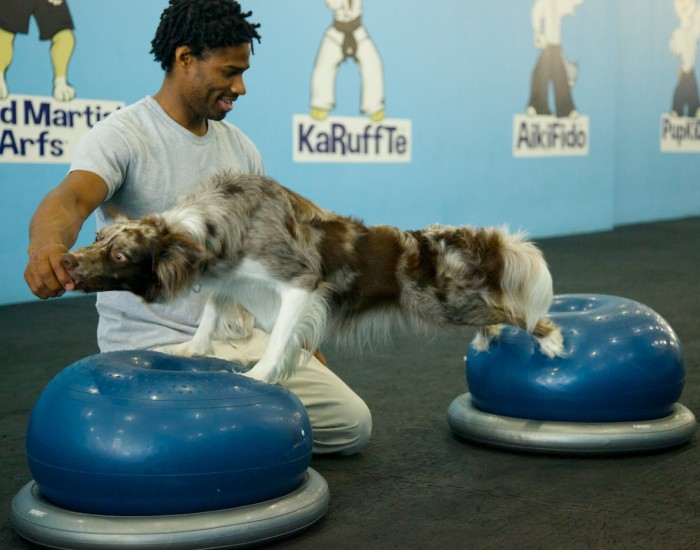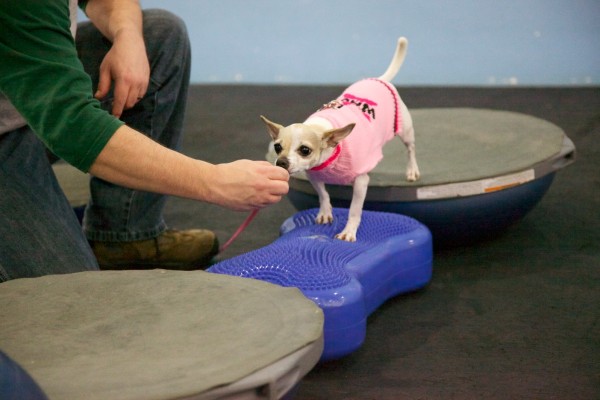Dog health and fitness can be tricky. Your dog may seem fit, but then gets winded on the first big hike of the year. Or, maybe you struggle with keeping your dog an ideal weight or worry you are putting too much stress on his joints.
Jeris Pugh owns a dog training facility called The Martial ARFS, where they specialize in canine fitness and conditioning programs to improve health, prevent injury or just for fun. His wife Dr. Eve Pugh DVM, CVA , is an emergency and rehabilitation veterinarian acts as an advisor to The Martial ARFS in order to make the exercises and conditioning protocols are safe for all types of dogs. Jeris answered our questions on how you can know if your dog is getting enough exercise.
Is there a set amount of exercise a dog should get based on breed or age or both?
JP: No. Although there are certain breed tendencies or characteristics, for example Labs and Border Collies are often considered breeds that need lots of activity. And young dogs are thought of as having “tons of energy.” But there’s nothing set in stone.
At The Martial ARFS we’ve seen lazy border collies and high energy senior dogs. Like so many things, exercise for your dog has to be based upon the needs of your individual dog.
How bad is the obesity problem in Dogs?
JP: Statistically, 54 percent of dogs are overweight. That means half of the people reading this have an overweight dog. What’s worse, the average dog owner isn’t aware of the fact that their dog is overweight. They actually think their dog is fine. When people see a healthy dog, they think it’s too skinny.
This is not breed specific, if you have a Rottie, they shouldn’t weigh “x” amount of pounds. Your dog should be an ideal weight as it relates to them.
There’s an easy way to know if your dog is a healthy weight. You should be able to easily feel each individual rib on your dog. The key words here are easily, and each.
For the record, we didn’t just make this up. Every canine body condition score chart, even the one in your veterinary’s office says the same thing. I challenge you to look at it. Under ideal, which is a 3 out of 5 or 5 out of 9 depending on the scale, it will say ribs easily felt. Some say easily palpable.
Keeping your dog weight ideal, instead of overweight, can actually add 2.5 years to their life. We’d all give almost anything to have another 2.5 years with our dogs. Keep them healthy and fit, and it’s possible.

Aside from their dog being overweight, what are some signs a dog is not getting enough exercise?
JP: A big one would be stamina. If a dog gets tired easily, barring any medical issues, this could be a sign that the dog isn’t getting enough activity. We routinely get dogs trotting on a treadmill for 15-20 minutes during the first session. If the dog has trouble with that, they’re probably out of shape.
Destructive behavior could be another sign. Chewing on the couch or other furniture, destroying pillows, papers, toys and garbage are all signs that the dog may have pent up energy and is looking for something to do.
Even disobedience like running off and not coming back can be a sign of lack of activity. If your dog enjoys running, but you never let them, when they get away why would they come back?
What are some signs their dog may be getting too much exercise?
JP: Recovery. If your dog seems sluggish, in pain or is even limping after a period or periods of activity, they probably over did it.
Hesitation or reluctance to engage in a physical activity your dog normally enjoys doing.
What is the difference between a dog running around the backyard, on his own for an hour, and the owner taking him on an hour run?
JP: Everything. To put it simply, what’s the difference between you working out by yourself, or with a friend? If right now I told you to go to the gym and workout how well do your think it would go? You’d probably go from one machine to another not quite sure of what to do or how they work and in the end not accomplish much at all.
That’s like your dog in the backyard. They go from one area to another not sure of what they should be doing and hardly ever accomplish anything as it relates to exercise. Even if they find running in the yard fun they’ll learn that fun doesn’t have anything to do with you!
However, if your dog exercises with you, several things happen:
- You’ll know exactly how much they exercise they have done.
- You can enjoy the time together which promotes bonding and better behavior.
- You can work on obedience during the whole time.
- They’ll learn that fun, physical activities happen with you, so they’ll want to be with you all the time, instead of running off.

In addition, you’ll learn more about your dog’s needs, what they’re capable of and whether or not they need more or less. With your dog in the yard without you, you’ll learn nothing about them.
When clients come to you, how do come up with a fitness and/or conditioning program for their dog?
JP: It’s a combination of the desires of the owner, the needs of the dog and what the dog can handle at his current fitness level.
Most owners come in because they have a high energy dog. That of course doesn’t necessarily mean the dog isn’t overweight, and unfortunately, many owners don’t realize it! Therefore, based on a dog’s weight or age, we might have to proceed slower in order to prevent any injuries.
Also just a dog may be a fit, high energy, young dog, we don’t just let them have at it. A high energy young dog is more of a danger to itself then a senior dog who would just as soon take it easy on the couch.
Is one type of exercise better than the other? More dangerous?
JP: A lot of that can depend upon the dog. Older dogs or young puppies shouldn’t run long distances. The compression on the joints can cause long term damage or exacerbate pre-existing conditions.
Uncontrolled off leash dog parks is by far the most dangerous. Whether it’s dog fights or dog collisions, it’s very easy for your dog to overdo it or get hurt it in a dog park. Dogs get injured just like we do: muscle strains, ligament tears and broken bones can all result for uncontrolled physical activity.

Even activities like fetch, dog agility or Frisbee can be dangerous if your dog has not had proper training and physical conditioning. I’m not saying you shouldn’t do these activities, I’m just saying that you have to be careful when doing them.
Any activity outside when the temperature is 80 degrees to more, such as distance running, is a big no-no. Your dog will want to run with you no matter what so you have to be the wise one and keep them safe.
The conditioning exercises and activities that we do at The Martial ARFS are both safe and effective. We’ve taken the time to learn what works well for a variety of dogs no matter age, breed, or size and how to make them stronger and fitter without over doing it.
Any special requirements for really tiny dogs (such as a teacup chi) or really big dogs (like a Dane)?
JP: Large breeds (over 80lbs), like the German Shepard, Rottweiler, Doberman Pincher, Labrador, etc., can be prone to hip & other orthopedic issues. Owners should be aware that a life of constant running and jumping without any conditioning can take a toll later in life with these dogs

Chondrodysplastic breeds (long back short legs), like a corgi and dachshund, can be prone to ruptured or herniated discs. Owners should be aware that constantly jumping, especially from big heights, (i.e. off the bed, couch or out of the car) with these dogs can lead to a ruptured or herniated disc.
Brachycephalic breeds (short nose, large eyes), like a Shih Tzu, French Bulldog, Boston Terrier or Pug, are prone to breathing trouble & heat stroke. Owners should be aware that these dogs shouldn’t do exercise outdoors in warm weather.
How do you suggest people begin an exercise routine with their dog?
JP: Slowly. Just because your dog is willing, doesn’t mean they should. Just like us, a dog shouldn’t go from being sedentary to running around all day. You’d never get up and run 3 or 4 miles after having been laying around for days or weeks.
And if you did, you’d be sore, complaining and not do it again the next day. Unfortunately, your dog won’t complain about being sore or tired even though they are. They’ll probably do it again. And that’s how injuries can happen.
At The Martial ARFS, we’re seeing more and more dogs come to us with ACL tears just from running around and playing. They probably over did it one day and just continued to keep going, until something finally gives.
What are some safety tips for owners while exercising their dogs?
Owners should look for the following signs of distress:
- Panting excessively, respiratory distress
- Eyes bulging
- Mouth wide open
- Tongue extended far out with the tip curled up
- Abdominal effort
- Wanting to slow or stop; resisting continuing activity
- Laying down
- Non-weight-bearing on any limb
- Yelping/crying
Don’t force your dog to participate in an activity or exercise, this can lead to injury or phobia. At The Martial ARFS we never drag a dog onto or over a piece of equipment, and we always reward a dog for a job well done.
Safety is about common sense. Just because your dog wants to do it doesn’t mean you should let them and just because you want your dog to do it doesn’t mean you should force them. You have to work as a team. Gradually work up to things. Don’t let your dog dictate how much & how often until you’re sure they can handle it.
About the Author
Based in Wilsonville, Ore., animal lover Kristina N. Lotz is a Certified Professional Dog Trainer – Knowledge Assessed (CPDT-KA) and a member of the Dog Writers Association of America. She is the founder of A Fairytail House. In her spare time, she trains and competes in a variety of performance events with her Shetland Sheepdogs and caters to her two rescue kitties. She smartly married a Veterinary Technician, who helps keep the fur kids happy and healthy, and provides a quick resource for articles.
